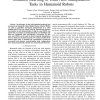Free Online Productivity Tools
i2Speak
i2Symbol
i2OCR
iTex2Img
iWeb2Print
iWeb2Shot
i2Type
iPdf2Split
iPdf2Merge
i2Bopomofo
i2Arabic
i2Style
i2Image
i2PDF
iLatex2Rtf
Sci2ools
99
Voted
IJHR
2008
2008
Imitation Learning of Dual-Arm Manipulation Tasks in Humanoid Robots
In this paper, we deal with imitation learning of arm movements in humanoid robots. Hidden Markov Models (HMM) are used to generalize movements demonstrated to a robot multiple times. They are trained with the characteristic features (key points) of each demonstration. Using the same HMM, key points that are common to all demonstrations are identified; only those are considered when reproducing a movement. We also show how HMM can be used to detect temporal dependencies between both arms in dual-arm tasks. We created a model of the human upper body to simulate the reproduction of dual-arm movements and generate natural-looking joint configurations from tracked hand paths. Results are presented and discussed.
Related Content
| Added | 12 Dec 2010 |
| Updated | 12 Dec 2010 |
| Type | Journal |
| Year | 2008 |
| Where | IJHR |
| Authors | Tamim Asfour, Pedram Azad, Florian Gyarfas, Rüdiger Dillmann |
Comments (0)

